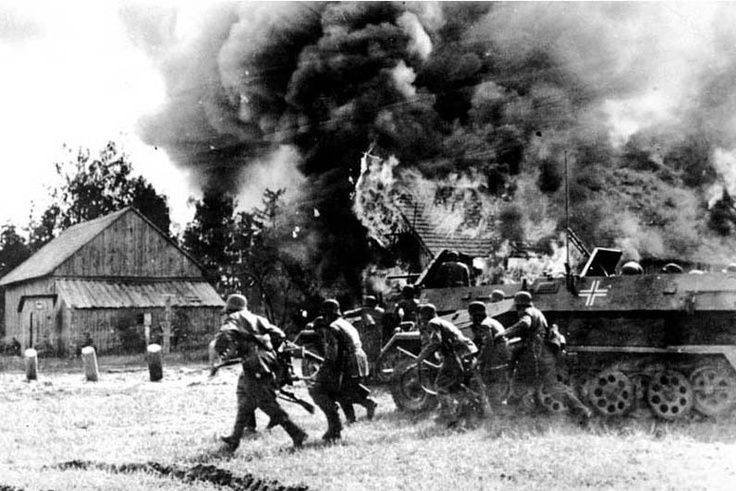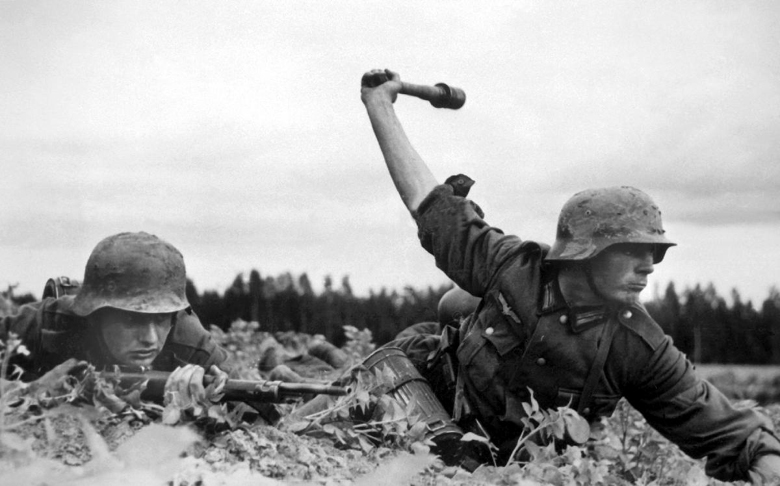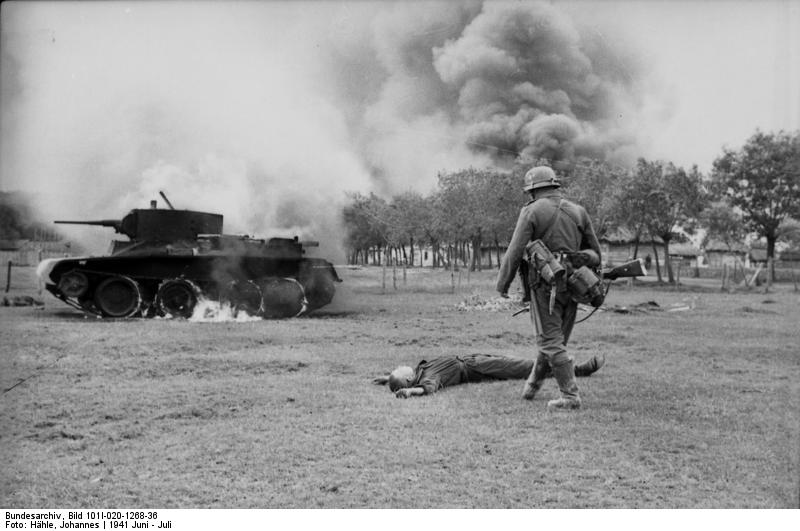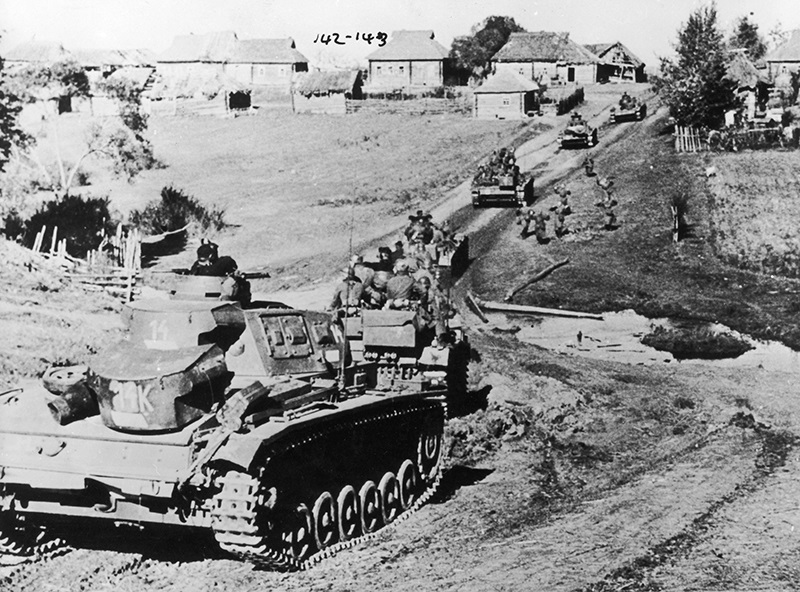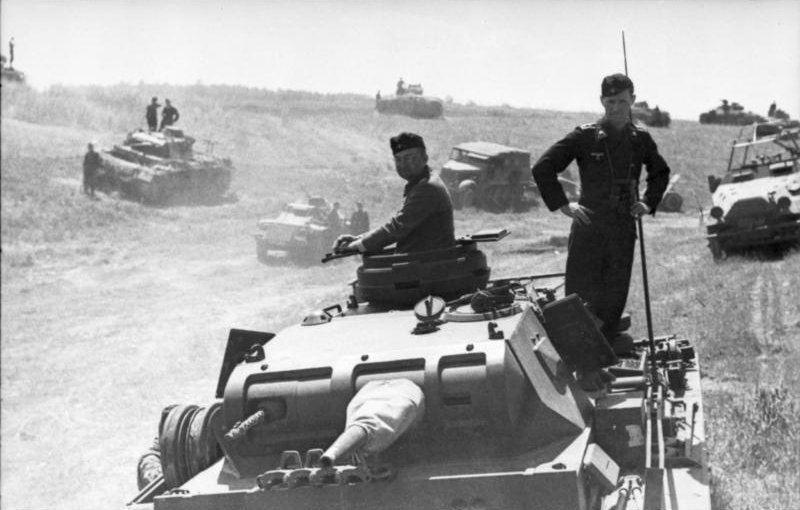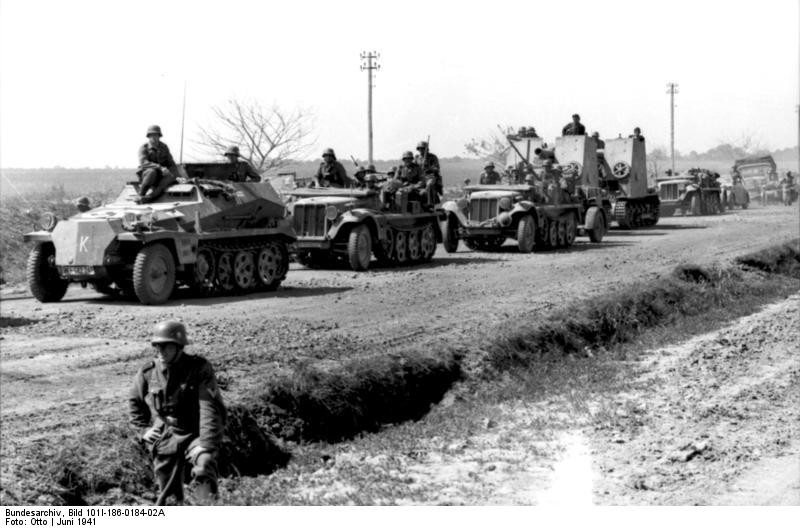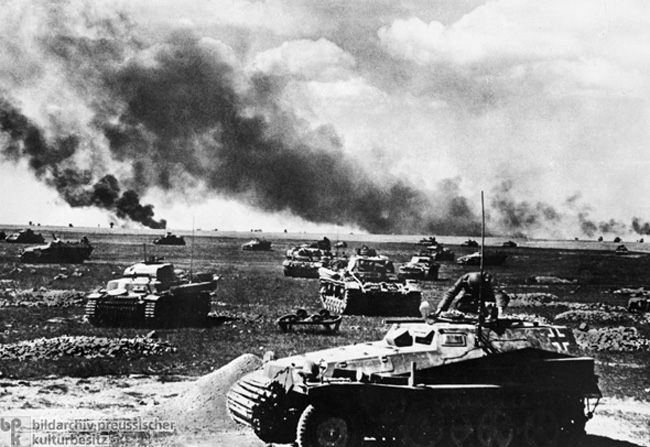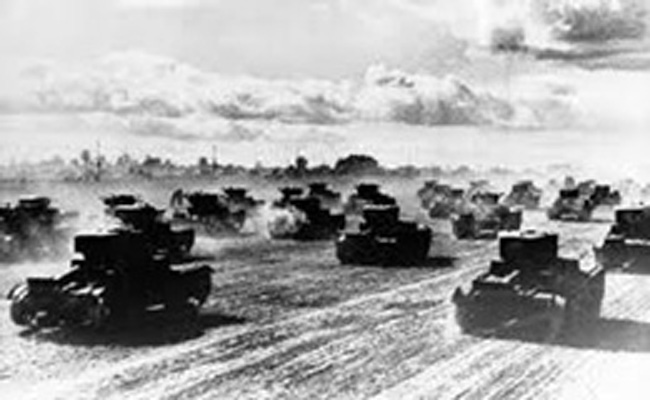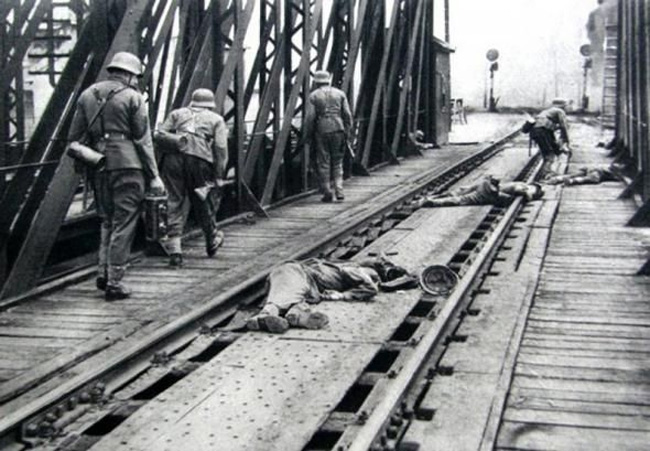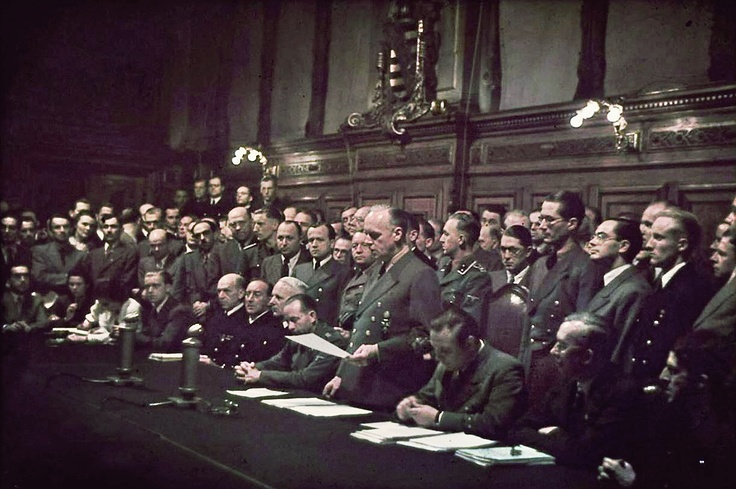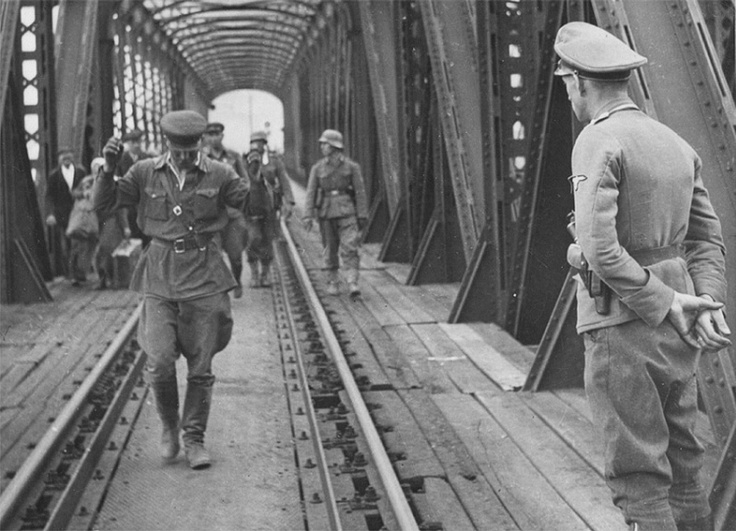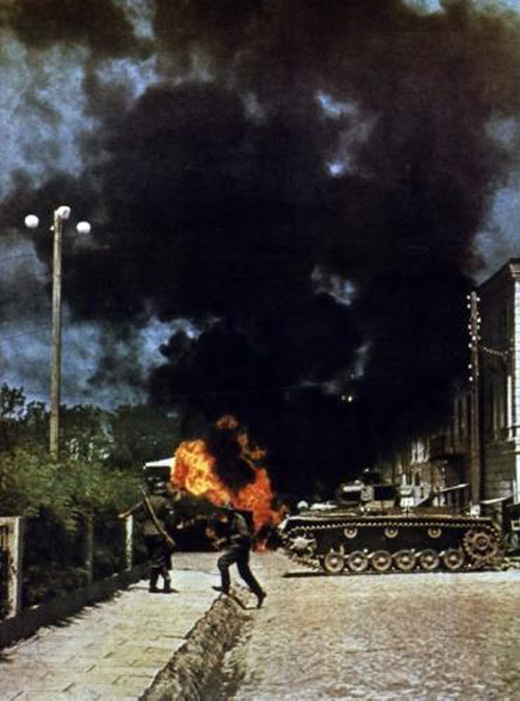Battle of the Atlantic
- U-48 returns to Kiel after her twelfth and last war cruise. This U-boat has sunk a total of 54 merchant ships of 322,000 tons and the sloop Dundee.
- The British naval trawler Beech is sunk in a German air attack at Scrabster with the loss of 1 of her crew.
- U-141 sinks the Swedish steamer Calabria (1277t) from Convoy SL-75 100 miles from Inishtrahull Lightship with the loss of 3 of her crew. 21 survivors are picked up by the British destroyer Sikh.
- U-77 sinks the British weather ship Arakaka (2379t) 450 miles east of St John's, Newfoundland with the loss of the entire crew of 40.
Britain, Politics
In the evening, Churchill broadcasts saying that help will be given to the Soviet Union. He says, 'Any state who fights Nazism will have our aid... It follows therefore that we shall give whatever help we can to Russia'.
[Diplomatic Relations
Germany declares war on the USSR. Italy and Rumania also declare war on the Soviet Union.
[German Raiders
The British steamer Balzac (5372t) is sunk by the German raider Atlantic in the South Atlantic with the loss of 3 crewmen. 45 crewmen are made prisoners of war.
[Mediterranean
The British submarine Union sinks the Italian steamer Pietro Querini (1004t) south of Pantelleria.
[North Africa
Gen Wavell is informed by his government of their decision to relieve him of his duties as Commander-in-Chief of British Middle East forces and send him to India as Commander-in-Chief of British forces there. The war in the Middle East loses a great protagonist.
[Eastern Front
Operation BARBAROSSA, the German attack on the Soviet Union, begins. Despite the massive preparations spread over many months and the numerous indications Stalin receives from many sources, the Soviet forces are taken almost completely by surprise and lose very heavily in the first encounters.
The German attack, however, should not have been unexpected. The Russian secret agent Richard Sorge, who is operating in Japan, had already reported it, specifying the forces which would be used as early as May 19. On June 15 he actually reported the precise date the assault would begin. Confirmation of Sorge's information had come on June 18 from a German deserter who crossed the Russian border to escape court-martial. The Russian leaders, however, were convinced that the Germans were neither able nor willing to relinquish their operations against the British. Therefore, they gave no credence to these reports.
|
|
|
|
The Germans have assembled almost 140 of their own divisions (figures very in different sources), including 17 Panzer and 13 motorized units. Army Group North, commanded by Field Marshal von Leeb, has 26 divisions and includes 2 infantry armies and Hoeppner's 4th Pzr Group. Field Marshal von Bock leads the largest German force, Army Group Center, with 51 divisions in 2 infantry armies and Guderian's 2nd and Hoth's 3rd Pzr Groups. Army Group South is led by Field Marshal von Rundstedt and includes 41 divisions in 3 infantry armies and 1 Pzr Group as well as 14 Rumanian and 2 Hungarian divisions. German units from Norway in Gen Falkenhorst's Norway Army will join the attack in alliance with the 21 divisions of the Finnish army who are keen to regain the territory lost to the USSR in 1940. There are more German units in general reserve and others allocated for security duties in captured territory. Altogether, the Germans deploy over 3,000,000 men, 7,100 guns and 3,300 tanks. Each army group has support from a complete Luftflotte. The total strength is 2,770 aircraft, almost the same as in France but now spread over a much larger front. Of the 3,300 tanks deployed in the attack only 1,400 are Mark III or IV types. This is a rather greater proportion of high-grade machines than in 1940 but Hitler's wish to have many of them armed with better guns has not been met. The increase in the number of Panzer divisions compared with 1940 has been achieved by a reorganization made in Sept 1940, when tank establishment was halved so that the number of divisions could be doubled. The strongest Panzer division in May 1940 had 300 tanks; now the strongest has 199. The new Panzer divisions have made considerable demands on scarce supplies of others vehicles also. As well as the tank force there is now a significant number of assault guns (250), mustered in special infantry-support battalions. The assault guns are formidable machines but they are administered and commanded by the artillery rather than the Panzer arm and will come to compete with the true tanks for scarce production resources.
The logistic preparations for Barbarossa have been particularly difficult for the German High Command. It has only been possible to assemble even a bare sufficiency of motor transport by using German, French and other captured types, which will, of course, cause many problems with spares and maintenance. The captured vehicles, especially the French, will be found to be notably unreliable. In addition to the motor transport the forces moving into the USSR still employ 625,000 horses. A further difficulty for the Germans is that the Soviet railroad system runs on a different gauge and must be converted if German rolling stock is to be used in captured areas. The Soviet forces also have their problems. Out of a total Red Army strength of over 230 divisions, about 170 are in the western part of the Soviet Union and 134, 32 of them armored, are with the formations facing the Germans. The total Soviet tank strength is around 24,000 machines but only a quarter of these are in running order. The Red Air Force has about 8,000 aircraft facing the Germans but, again, many are obsolete or in poor repair. In all classes of equipment the most modern Soviet designs are simple and durable and at least as good as the German equivalent.
|
|
|
|
There are important gaps in the German's information about Soviet strength and equipment. They underestimate badly the manpower the Soviets have available and take too little account of the speed with which the Soviets will prepare new army and militia units. They also believe that the Soviets have a total of 10,000 tanks and they have no real information about the superior T34 and KVI tanks. There are 1,475 of these in various armored divisions. The KV type is almost invulnerable to the German tanks' guns.
However, the considerable Soviet resources are less formidable than their extent suggests. Following the purges of the late 1930's a large part of the remaining senior leadership of the Red Army had been made up from the 'Cavalry Army' clique, old associates of Stalin not always distinguished for their military talents. Marshal Budenny typefies this group, perhaps owing his preferment to his position as one of Stalin's favorite drinking companions.
The Winter War with Finland exposed many weaknesses within the Red Army and led to many changes. Some, like the re-creation of the mechanized corps in September 1940, are undoubtedly sensible but others have been wasteful. All the changes, sensible or not, have been made in an atmosphere of haste which has made assimilating them more difficult. Training has also been poor. Some of the tank drivers and mechanics have had about an hour's instruction altogether on their new T34's and KVI's. Soviet deployment is also very weak. Some units which are supposedly part of the front line are as much as 200 miles away in barracks or on training grounds. Other formations, 10th Army of the Western Front is the best example, are too far forward in dangerously exposed salients. Plans are under way to being reinforcements from the units deployed in the Far East but these have not yet become effective. Thus, despite Soviet manpower resources and useful stocks of equipment, the weakness of their tactical system, training and deployment means that they could hardly be worse placed.
Marshal Timoshenko is Commissar for Defense and Gen Zhukov is Chief of the General Staff. In the line from the north to south are Kuznetsov's Northwest Front, Pavlov's West Front, Kirponos's Southwest Front and Tyulenev's South Front. The balance of forces differs from the Germans in showing a slight preponderance in the south. Kuznetsov, Pavlov and Kirponos will all be replaced early in the campaign.
The German plan is for an advance by all 3 army groups. Von Leeb is to go for Leningrad, von Bock for Smolensk and von Rundstedt for Kiev. Army Group Center is to be prepared to give support to the flanks of the thrust rather than to press toward Moscow after Smolensk. This decision has been Hitler's own and is generally regarded by later military critics as unsound. Equally controversial is the timing of the attack. Since the war it has often been argued that despite errors in Hitler's direction of the campaign, the main reason why the German army did not reach Moscow and win the war in the autumn and early winter was the weather and that, if Barbarossa had been begun earlier in the year, Moscow would have fallen. However, it is by no means certain that even with a few weeks' grace the Germans would have been able to finish off their Moscow attack. Also, it is almost certain that Barbarossa could not have been started any earlier. The Greek campaign did not cause any delay and the Yugoslav campaign almost none (see April 25-29). The real causes of delay were that the winter and spring of 1940 was particularly wet, flooding the rivers of Poland and softening the ground. Even in early June the Bug was well over its banks in many places on the front of Army Group Center. It should not be forgotten also that any delay meant that the Germans could add tanks and lorries to their units. All this discussion is somewhat academic. The Germans were in no particular hurry because they believed that they could win in a matter of weeks, and foreign military opinion agreed with them. The Red Army proved everyone wrong.
On the first day of the attack almost everything goes the German way. The attack begins at 0300 hours with advances on the ground and simultaneous air strikes. The Luftwaffe begins its operations very early in order to be over the Soviet bases exactly at zero hour. By noon the Soviet Air Force has lost around 1,200 planes. The land battle is equally successful. Army Group North's Panzer spearhead advances 40 miles during the day and Army Group Center captures most of the Bug bridges intact. During the first 4 days Manstein's LVI Pzr Corps with Army Group North will advance 185 miles; Guderian's Pzr Group will make 270 miles in the first week. Other forces will do equally will. One setback for Army Group Center is that, although they win control of the town of Brest-Litovsk, they will not be able to take the medieval citadel or use the communications network centering there for several days.
|
|
|
|
At 11:15am Moscow announces the German attack to the Russian people: 'At 4 o'clock this morning, with no declaration of war and no demands made on the Soviet Union, German troops have assailed our country, attacked our frontier at many points and bombed Zhitomir, Kiev, Sevastopol, Kaunas and other places. Similar attacks by bombers and artillery have also been launched from Rumanian and Finnish territory. This incredible attack on our country is an act of treachery unequalled in the history of civilized nations. It has been carried out despite the existance of a non-aggression pact between the Soviet Union and Germany...and although the German government has never had the least cause for complaint about the way in which the Soviet Union has fulfilled its own obligations. The entire responsibility for this act of rapint must therefore fall on the Nazi rulers ... The government of the Soviet Union is deeply convinced that the whole population of our country will do its duty ... The government appeals to you, men and women, citizens of the Soviet Union, to unite more closely than ever round the glorious Bolshevist party, the Soviet government and our great leader, Comrade Stalin. Our cause is just. The enemy will be defeated. Victory will be ours.' Stalin does not actually speak to the people himself until 11 days later on July 3.
A supreme defense council, the Stavka, is set up immediately and 15 million men are called up.
NORTHERN SECTOR
The 4th Panzer Group makes good progress against the Northwest Front, especially the LVI Panzer Corps, which smashes the Soviet 8th Army's left flank and heads toward the Dvina River. The German 18th Army advances along the coast while the 16th Army heads for the Niemen River, forcing apart the Soviet 8th and 11th Armies. Heavy German artillery barrages and Luftwaffe attacks hinder Red Army movements.
CENTRAL SECTOR
The 4th Panzer Group pierces the front between the Northwest and Western Fronts. Reinforcements from the III and XII Mechanized Corps come under sustained Luftwaffe attack, and the German 9th Army inflicts heavy casualties on the Soviet 3rd Army. Meanwhile, the 2nd Panzer Group attacks Brest-Litovsk, whose garrison withdraws into the citadel. Under relentless attacks the Soviet 3rd, 4th and 10th Armies begin to fall apart, compounded by Luftwaffe strikes against troop concentrations at Bialystok, Grodno, Lida, Volkosky, Brest-Litobsk; and against airfields, and fuel and ammunition dumps. As the German 9th and 4th Armies maul the Soviet 10th Army, the Russian VI Cavalry Corps is virtually wiped out. The 10th Army begins to withdraw, while the XIV Mechanized Corps begins a day-long battle with the 18th Panzer Division. By evening the Soviet 10th Army has suffered severe casualties.
SOUTHERN SECTOR
The Luftwaffe achieves almost immediate air superiority, destroying more than 300 aircraft in the first three hours of operations. The 1st Panzer Group and the 6th Army attack the Soviet 3rd, 14th and 6th Armies as the Germans cross the Bug River. The German 17th Army attacks toward Lvov. As the day wears on, the Soviet XV Rifle Corps disintegrates at the junction of the 4th and 5th Armies. Gen Mikhail Kirponos, the Southwest Front commander, counterattacks with the IV and XXII Mechanized Corps but fails to halt the panzers.[MORE]
Order of Battle - Germans --Soviets
[